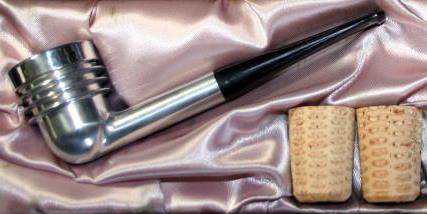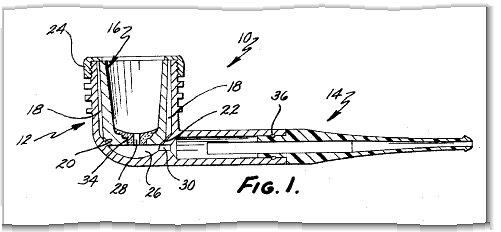The Aristocob System Pipe
 Aristocob
Newcomer
Aristocob
Newcomer
First off, the answer to "What is it?" is that it is/was a system pipe that was introduced in the mid-1960's by its inventor. It was made from aluminum in an "Art Deco" or "Streamlined" style, with cooling radiator fins around the exterior of the bowl. The goal of the pipe was to provide the cool and sweet smoking experience of a traditional corn cob pipe without the appearance of a corn cob pipe by housing a replaceable corn cob liner.
Here's a clip from something I wrote on my old blog:
"Invented in 1964, it was sold by the Al Cobb Corp of Grand Haven, Michigan. Later it was sold by Aristocob Inc. of Caledonia Michigan, and finally by the Missouri Meerschaum Company of Washington Missouri. Missouri Meerschaum continued to make corn cob cores until the machine that turned the cobs finally wore out in 1983."
At the time that the Aristocob pipe was patented there were several other system pipes that held corn cob liners, but they all had the same problem: Cobs swell when smoked and they swell even more when they are trapped inside a confined space. The Aristocob pipe design allowed for this expansion by having a space between the liner and the walls of the pipe.
Here's a quote from the patent:
"Basically, these problems centered upon the characteristic tendency of corn cob to burn away after being repeatedly exposed to the temperatures normally present in pipe bowls. As a result of this tendency, the bottoms of the corn cob inner bowls would very quickly burn away, allowing bits of tobacco and live embers to communicate directly with the stem of the pipe, thereby causing great discomfort to the smoker. Furthermore, the absorption of tars and other substances by the cob structure caused the sides of the inner bowl to swell outwardly, resulting in the seizure of the inner and outer bowls. Thus, not only did the corn cob bowls burn out so quickly that they were economically unfeasible; they could not even be extracted from the outer bowl of the pipe when they became burned out, and actually had to be cut or broken away."
Another issue that the Aristocob pipe was attempting to resolve was that previous corn cob lined system pipes had the tendency to burn through at the bottom of the chamber. This was caused by the fact that the draught hole was always located dead-center in the bottom of the chamber, which in the case of a cob is soft pith. Other pipe designs included threaded metal adaptors that had to be fished out of the used (stinky) cob lines to be attached to a replacement cob liner. The Aristocob pipe solved these problems by having a solid bottom added to the liner and to then retain the liner in the bowl by adding the threaded ring to the top, which adds just a little downward pressure on the cob, seating it firmly into a tapered recess. (See illustration from the US patent below) The patent describes a ceramic bottom that was poured or pressed into the cob liner, but this was abandoned for a simple, square stamped steel "washer". This washer prevents burn-through without adding the addition costs that drilling out and plugging with wood, for example, would create.
My fascination with the Arstocob system pipe lead me to adopt that name as my online profile name years ago. As for the Aristocob pipe, I have a bunch of them and my obsession with them lead to be creating a blog to detail the pipe's history and to document the street value of them as auctions ended on eBay. I think I inadvertently revived interest in them because I used to be able to snatch them up for $3-5 and now they routinely sell for $35 and up! Later, when I was searching for a name for our old eBay Store and more recently our website, I immediately knew that www.Aristocob.com was a winner.
My old blog can still be found at http://aristocob.blogspot.com. You'll want to scroll to the bottom of the page and click "Older Posts" to see the most interesting posts.
Here's a pic of one iteration of the packaging of the Aristocob pipe. The packaging changed over the years but it always included at least two of the corn cob liners.

Here's a pic from the US patent. See the patent here: https://patents.google.com/patent/US3292639A/en

Comments
I will try your suggestion on posting in a different browser, and also cleaning out my cache for good measure. Thanks for the suggestion.